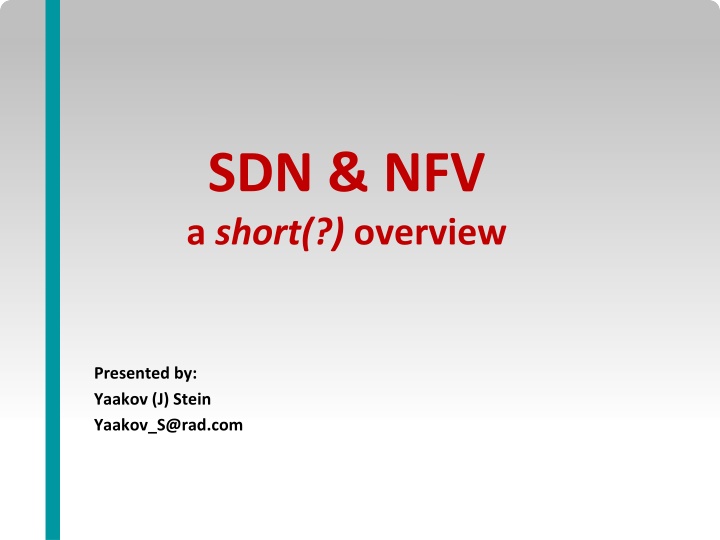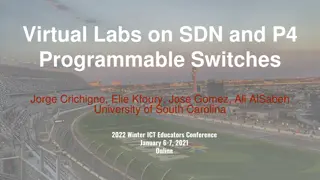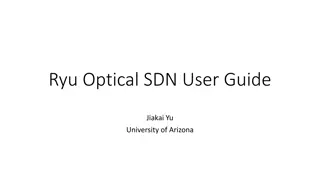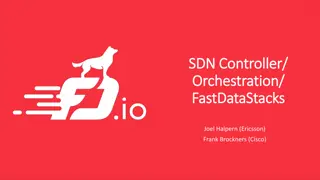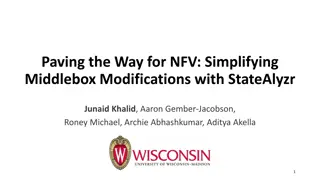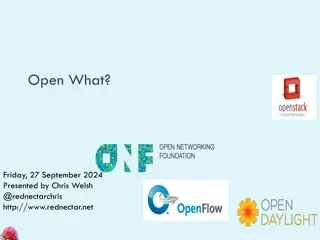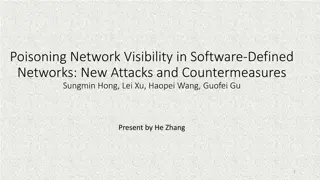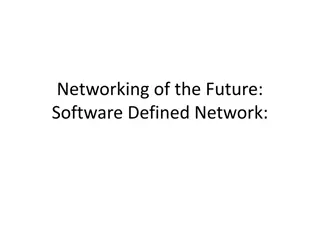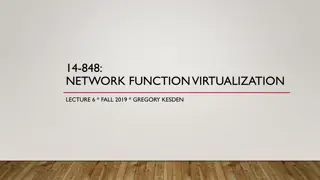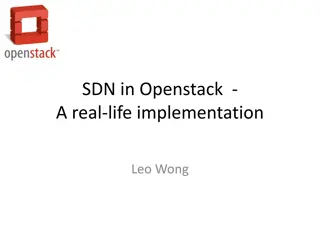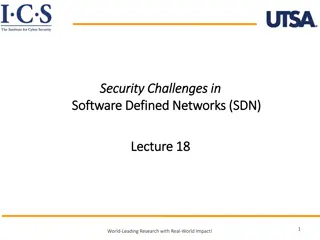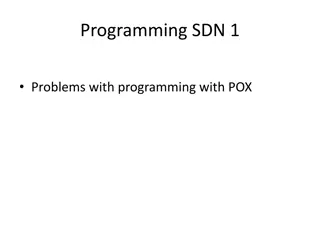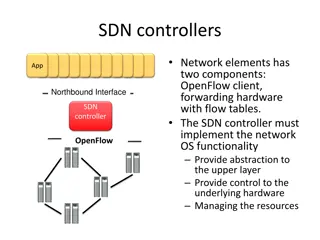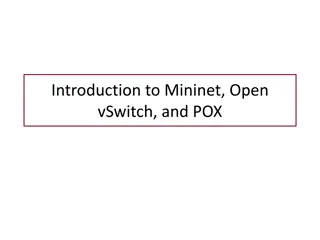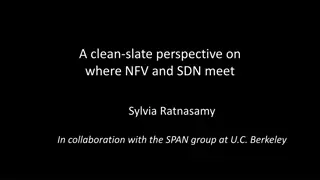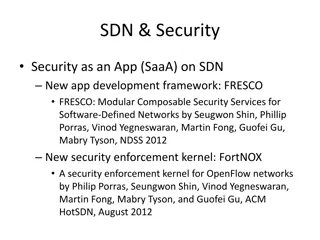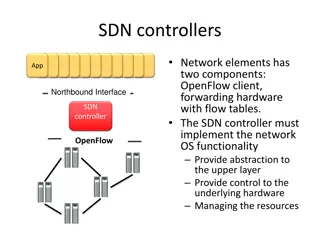The Evolution of SDN and NFV
SDN (Software-Defined Networking) and NFV (Network Functions Virtualization) have emerged due to shifts in the computing and communications landscape. SDN addresses the blurring line between computation and communications, while NFV responds to changes in profitability for service providers. These technologies offer rich communication services, combining connectivity with network functionalities, and aim to streamline service deployment and optimization. The software-defined approach aims to accelerate service development and deployment compared to traditional networking methods.
Download Presentation

Please find below an Image/Link to download the presentation.
The content on the website is provided AS IS for your information and personal use only. It may not be sold, licensed, or shared on other websites without obtaining consent from the author.If you encounter any issues during the download, it is possible that the publisher has removed the file from their server.
You are allowed to download the files provided on this website for personal or commercial use, subject to the condition that they are used lawfully. All files are the property of their respective owners.
The content on the website is provided AS IS for your information and personal use only. It may not be sold, licensed, or shared on other websites without obtaining consent from the author.
E N D
Presentation Transcript
SDN & NFV a short(?) overview Presented by: Yaakov (J) Stein Yaakov_S@rad.com Yaakov (J) Stein SDN & NFV 1
Why SDN and NFV ? Before explaining what SDN and NFV are we need to explain why SDN and NFV are Its all started with two related trends ... 1. The blurring of the distinction between computation and communications (and thus between algorithms and protocols) revealing a fundamental disconnect between software and networking 2. The decrease in profitability of traditional communications service providers along with the increase in profitability of Cloud and Over The Top service providers The 1stled directly to SDN and the 2ndto NFV but today both are intertwined Yaakov (J) Stein SDN & NFV 2
1. Computation and communications Once there was little overlap between communications (telephone, radio, TV) and computation (computers) Actually communications devices always ran complex algorithms but these are hidden from the user But this dichotomy has become blurred Most home computers are not used for computation at all rather for entertainment and communications (email, chat, VoIP) Cellular telephones have become computers The differentiation can still be seen in the terms algorithm and protocol Protocol design is fundamentally harder since there are two interacting entities (the interoperability problem) SDN academics claim that packet forwarding is a computation problem and protocols as we know them should be avoided Yaakov (J) Stein SDN & NFV 3
1. Rich communications services Traditional communications services are pure connectivity services transport data from A to B with constraints (e.g., minimum bandwidth, maximal delay) with maximal efficiency (minimum cost, maximized revenue) Modern communications services are richer combining connectivity and network functionalities e.g., firewall, NAT, load balancing, CDN, parental control, ... Such services further blur the computation/communications distinction and make service deployment optimization more challenging Yaakov (J) Stein SDN & NFV 4
1. Software and networking speed Today, developing a new iOS/Android app takes hours to days but developing a new communications service takes months to years Even adding new instances of well-known services is a time consuming process for conventional networks When a new service types requires new protocols, the timeline is protocol standardization (often in more than one SDO) hardware development interop testing vendor marketing campaigns and operator acquisition cycles staff training deployment how long has it been since the first IPv6 RFC ? This leads to a fundamental disconnect between software and networking development timescales An important goal of SDN and NFV is to create new network functionalities at the speed of software Yaakov (J) Stein SDN & NFV 5
2. Todays communications world Today s infrastructures are composed of many different Network Elements (NEs) sensors, smartphones, notebooks, laptops, desk computers, servers, DSL modems, Fiber transceivers, SONET/SDH ADMs, OTN switches, ROADMs, Ethernet switches, IP routers, MPLS LSRs, BRAS, SGSN/GGSN, NATs, Firewalls, IDS, CDN, WAN aceleration, DPI, VoIP gateways, IP-PBXes, video streamers, performance monitoring probes , performance enhancement middleboxes, etc., etc., etc. New and ever more complex NEs are being invented all the time, and while equipment vendors like it that way Service Providers find it hard to shelve and power them all ! In addition, while service innovation is accelerating the increasing sophistication of new services the requirement for backward compatibility and the increasing number of different SDOs, consortia, and industry groups which means that it has become very hard to experiment with new networking ideas NEs are taking longer to standardize, design, acquire, and learn how to operate NEs are becoming more complex and expensive to maintain Yaakov (J) Stein SDN & NFV 6
2. The service provider crisis $ Service Provider bankruptcy point margin time This is a qualitativepicture of the service provider s world Revenue is at best increasing with number of users Expenses are proportional to bandwidth doubling every 9 months This situation obviously can not continue forever ! Yaakov (J) Stein SDN & NFV 7
Two complementary solutions Software Defined Networks (SDN) SDN advocates replacing standardized networking protocols with centralized software applications that configure all the NEs in the network Advantages: easy to experiment with new ideas control software development is much faster than protocol standardization centralized control enables stronger optimization functionality may be speedily deployed, relocated, and upgraded Network Functions Virtualization (NFV) NFV advocates replacing hardware network elements with software running on COTS computers that may be housed in POPs and/or datacenters Advantages: COTS server price and availability scales with end-user equipment functionality can be located where-ever most effective or inexpensive functionalities may be speedily combined, deployed, relocated, and upgraded Yaakov (J) Stein SDN & NFV 8
SDN Yaakov (J) Stein SDN & NFV 9
Abstractions SDN was triggered by the development of networking technologies not keeping up with the speed of software application development Computer science theorists theorized that this derived from not having the required abstractions In CS an abstraction is a representation that reveals semantics needed at a given level while hiding implementation details thus allowing a programmer to focus on necessary concepts without getting bogged down in unnecessary details Programming is fast because programmers exploit abstractions Example: It is very slow to code directly in assembly language (with few abstractions, e.g. opcode mnemonics) It is a bit faster to coding in a low-level language like C (additional abstractions : variables, structures) It is much faster coding in high-level imperative language like Python It is much faster yet coding in a declarative language (coding has been abstracted away) It is fastest coding in a domain-specific language (only contains the needed abstractions) In contrast, in protocol design we return to bit level descriptions every time Yaakov (J) Stein SDN & NFV 10
Packet forwarding abstraction The first abstraction relates to how network elements forward packets At a high enough level of abstraction all network elements perform the same task Abstraction 1 Packet forwarding as a computational problem The function of any network element (NE) is to receive a packet observe packet fields apply algorithms (classification, decision logic) optionally edit the packet forward or discard the packet For example An Ethernet switch observes MAC DA and VLAN tags, performs exact match, forwards the packet A router observes IP DA, performs LPM, updates TTL, forwards packet A firewall observes multiple fields, performs regular expression match, optionally discards packet We can replace all of these NEs with a configurable whitebox switch Yaakov (J) Stein SDN & NFV 11
Network state and graph algorithms How does a whitebox switch learn its required functionality ? Forwarding decisions are optimal when they are based on full global knowledge of the network With full knowledge of topology and constraints the path computation problem can be solved by a graph algorithm While it may sometimes be possible to perform path computation (e.g., Dijkstra) in a distributed manner It makes more sense to perform them centrally Abstraction 2 Routing as a computational problem Replace distributed routing protocols with graph algorithms performed at a central location Note with SDN, the pendulum that swung from the completely centralized PSTN to the completely distributed Internet swings back to completely centralized control Yaakov (J) Stein SDN & NFV 12
Configuring the whitebox switch How does a whitebox switch acquire the information needed to forward that has been computed by an omniscient entity at a central location ? Abstraction 3 Configuration Whitebox switches are directly configured by an SDN controller Conventional network elements have two parts: 1. smart but slow CPUs that create a Forwarding Information Base 2. fast but dumb switch fabrics that use the FIB Whitebox switches only need the dumb part, thus eliminating distributed protocols not requiring intelligence The API from the SDN controller down to the whitebox switches is conventionally called the southbound API (e.g., OpenFlow, ForCES) Note that this SB API is in fact a protocol but is a simple configuration protocol not a distributed routing protocol Yaakov (J) Stein SDN & NFV 13
Separation of data and control You will often hear stated that the defining attribute of SDN is the separation of the data and control planes This separation was not invented recently by SDN academics Since the 1980s all well-designed communications systems have enforced logical separation of 3 planes : data plane (forwarding) control plane (e.g., routing ) management plane (e.g., policy, commissioning, billing) What SDN really does is to 1) insist on physical separation of data and control 2) erase the difference between control and management planes management plane control plane data plane Yaakov (J) Stein SDN & NFV 14
Control or management What happened to the management plane ? Traditionally the distinction between control and management was that : management had a human in the loop while the control plane was automatic With the introduction of more sophisticated software the human could often be removed from the loop The difference that remains is that the management plane is slow and centralized the control plane is fast and distributed So, another way of looking at SDN is to say that it merges the control plane into a single centralized management plane Yaakov (J) Stein SDN & NFV 15
SDN vs. distributed routing Distributed routing protocols are limited to finding simple connectivity minimizing number of hops (or other additive cost functions) but find it hard to perform more sophisticated operations, such as guaranteeing isolation (privacy) optimizing paths under constraints setting up non-overlapping backup paths (the Suurballe problem) integrating networking functionalities (e.g., NAT, firewall) into paths This is why MPLS created the Path Computation Element architecture An SDN controller is omniscient (the God box) and holds the entire network description as a graph on which arbitrary optimization calculations can be performed But centralization comes at a price the controller is a single point of failure (more generally different CAP-theorem trade-offs are involved) the architecture is limited to a single network additional (overhead) bandwidth is required additional set-up delay may be incurred Yaakov (J) Stein SDN & NFV 16
Flows It would be too slow for a whitebox switch to query the centralized SDN controller for every packet received So we identify packets as belonging to flows Abstraction 4 Flows (as in OpenFlow) Packets are handled solely based on the flow to which they belong Flows are thus just like Forwarding Equivalence Classes Thus a flow may be determined by an IP prefix in an IP network a label in an MPLS network VLANs in VLAN cross-connect networks The granularity of a flow depends on the application Yaakov (J) Stein SDN & NFV 17
Control plane abstraction In the standard SDN architecture, the SDN controller is omniscient but does not itself program the network since that would limit development of new network functionalities With software we create building blocks with defined APIs which are then used, and perhaps inherited and extended, by programmers With networking, each network application has a tailored-made control plane with its own element discovery, state distribution, failure recovery, etc. Note the subtle change of terminology we have just introduced instead of calling switching, routing, load balancing, etc. network functions we call them network applications (similar to software apps) Abstraction 5 NorthboundAPIs instead of protocols Replace control plane protocols with well-defined APIs to network applications This abstraction hide details of the network from the network application revealing high-level concepts, such as requesting connectivity between A and B but hiding details unimportant to the application such as details of switches through which the path A B passes Yaakov (J) Stein SDN & NFV 18
SDN overall architecture app app app app Network Operating System northbound interface SDN controller southbound interface (e.g., OpenFlow, ForCES) SDN switch SDN switch SDN switch SDN switch Network SDN switch SDN switch Yaakov (J) Stein SDN & NFV 19
Network Operating System For example, a computer operating system sits between user programs and the physical computer hardware reveals high level functions (e.g., allocating a block of memory or writing to disk) hides hardware-specific details (e.g., memory chips and disk drives) We can think of SDN as a Network Operating System Note: apps can be added without changing OS user user network application network application user network application application application application Computer Operating System Network Operating System HW HW whitebox switch whitebox switch HW whitebox switch component component component Yaakov (J) Stein SDN & NFV 20
SDN overlay model We have been discussing the purist SDN model where SDN builds an entire network using whiteboxes For non-greenfield cases this model requires upgrading (downgrading?) hardware to whitebox switches An alternative model builds an SDN overlay network The overlay tunnels traffic through the physical network running SDN on top of switches that do not explicitly support SDN Of course you may now need to administer two separate networks Yaakov (J) Stein SDN & NFV 21
SDN vs. conventional NMS So and if so 1) is OF/SDN simply a new network management protocol ? 2) is it better than existing NMS protocols ? 1) Since it is replaces both control and management planes it is much more dynamic than present management systems 2) Present systems all have drawbacks as compared to OF : SNMP(currently the most common mechanism for configuration and monitoring) is not sufficiently dynamic or fine-grained (has limited expressibility) not multivendor (commonly relies on vendor-specific MIBs) Netconf just configuration - no monitoring capabilities CLI scripting not multivendor (but I2RS is on its way) Syslog mining just monitoring - no configuration capabilities requires complex configuration and searching Yaakov (J) Stein SDN & NFV 22
Organizations working on SDN The Open Networking Forum (ONF) responsible for OpenFlow and related work promoting SDN principles recently merged with ON.Lab IRTF SDNRG see RFC 7426 ITU-T SG13 working on architectural issues and many open source communities, including : OpenDaylight ON.Lab (ONOS) Open vSwitch Ryu Open Source SDN (OSSDN sponsored by ONF) Yaakov (J) Stein SDN & NFV 23
NFV Yaakov (J) Stein SDN & NFV 24
Virtualization of computation In the field of computation, there has been a major trend towards virtualization Virtualization here means the creation of a virtual machine (VM) that acts like an independent physical computer A VM is software that emulates hardware (e.g., an x86 CPU) over which one can run software as if it is running on a physical computer The VM runs on a host machine and creates a guest machine (e.g., an x86 environment) A single host computer may host many fully independent guest VMs and each VM may run different Operating Systems and/or applications For example a datacenter may have many racks of server cards each server card may have many (host) CPUs each CPU may run many (guest) VMs A hypervisor is software that enables creation and monitoring of VMs Yaakov (J) Stein SDN & NFV 25
Network Functions Virtualization CPUs are not the only hardware device that can be virtualized Many (but not all) NEs can be replaced by software running on a CPU or VM This would enable using standard COTS hardware (whitebox servers) reducing CAPEX and OPEX fully implementing functionality in software reducing development and deployment cycle times, opening up the R&D market consolidating equipment types reducing power consumption optionally concentrating network functions in datacenters or POPs obtaining further economies of scale. Enabling rapid scale-up and scale-down For example, switches, routers, NATs, firewalls, IDS, etc. are all good candidates for virtualization as long as the data rates are not too high Physical layer functions (e.g., Software Defined Radio) are not ideal candidates High data-rate (core) NEs will probably remain in dedicated hardware Yaakov (J) Stein SDN & NFV 26
Potential VNFs Potential Virtualized Network Functions forwarding elements: Ethernet switch, router, Broadband Network Gateway, NAT virtual CPE: demarcation + network functions + VASes mobile network nodes: HLR/HSS, MME, SGSN, GGSN/PDN-GW, RNC, NodeB, eNodeB residential nodes: home router and set-top box functions gateways: IPSec/SSL VPN gateways, IPv4-IPv6 conversion, tunneling encapsulations traffic analysis: DPI, QoE measurement QoS: service assurance, SLA monitoring, test and diagnostics NGN signalling: SBCs, IMS converged and network-wide functions: AAA servers, policy control, charging platforms application-level optimization: CDN, cache server, load balancer, application accelerator security functions: firewall, virus scanner, IDS/IPS, spam protection Yaakov (J) Stein SDN & NFV 27
Function relocation Once a network functionality has been virtualized it is relatively easy to relocate it By relocation we mean placing a function somewhere other than its conventional location e.g., at Points of Presence and Data Centers Many (mistakenly) believe that the main reason for NFV is to move networking functions to data centers where one can benefit from economies of scale Some telecomm functionalities need to reside at their conventional location Loopback testing E2E performance monitoring but many don t routing and path computation billing/charging traffic management DoS attack blocking Note: even nonvirtualized functions can be relocated Yaakov (J) Stein SDN & NFV 28
Example of relocation with SDN SDN is, in fact, a specific example of function relocation In conventional IP networks routers perform 2 functions forwarding observing the packet header consulting the Forwarding Information Base forwarding the packet routing communicating with neighboring routers to discover topology (routing protocols) runs routing algorithms (e.g., Dijkstra) populating the FIB used in packet forwarding SDN enables moving the routing algorithms to a centralized location replace the router with a simpler but configurable whitebox switch install a centralized SDN controller runs the routing algorithms (internally w/o on-the-wire protocols) configures the NEs by populating the FIB Yaakov (J) Stein SDN & NFV 29
Distributed NFV The idea of optimally placing virtualized network functions in the network from edge (CPE) through aggregation through PoPs and HQs to datacenters is called Distributed-NFV (DNFV) Optimal location of a functionality needs to take into consideration: resource availability (computational power, storage, bandwidth) real-estate availability and costs energy and cooling management and maintenance other economies of scale security and privacy regulatory issues For example, consider moving a DPI engine from where it is needed this requires sending the packets to be inspected to a remote DPI engine If bandwidth is unavailable or expensive or excessive delay is added then DPI must not be relocated even if computational resources are less expensive elsewhere! Yaakov (J) Stein SDN & NFV 30
vCPE and uCPE The original attempts at NFV PoCs focused on Cloud NFV Recent attention has been on NFV for Customer Premises Equipment vCPE virtualizing CPE functionality and relocating in the cloud uCPE providing hosting capabilities in the CPE and relocating to it OpenStack Compute node VNF VNF OpenStack Controller Hypervisor Customer Site Data Center Customer Network Network Yaakov (J) Stein SDN & NFV 31
Service function chaining Service (function) chaining is a new SDN+NFV application that has been receiving a lot of attention Its main application is inside data centers but there are also applications in mobile networks A packet may need to be steered through a chain of functions (services) Examples of services (functions) : firewall DPI for analytics NAT CDN billing load balancing The chaining can be performed by SDN or static routing, source routing, segment routing, policy-based routing, new mechanisms It is useful to be able to pass metadata between functions Yaakov (J) Stein SDN & NFV 32
ETSI NFV-ISG architecture Yaakov (J) Stein SDN & NFV 33
MANO ? VIM ? VNFM? NFVO? Traditional NEs have NMS (EMS) and perhaps are supported by an OSS NFV has in addition the MANO (Management and Orchestration) containing : an orchestrator VNFM(s) (VNF Manager) VIM(s) (Virtual Infrastructure Manager) lots of reference points (interfaces) ! The VIM (usually OpenStack) manages NFVI resources in one NFVI domain life-cycle of virtual resources (e.g., set-up, maintenance, tear-down of VMs) inventory of VMs FM and PM of hardware and software resources exposes APIs to other managers The VNFM manages VNFs in one VNF domain life-cycle of VNFs (e.g., set-up, maintenance, tear-down of VNF instances) inventory of VNFs FM and PM of VNFs The NFVO is responsible for resource and service orchestration controls NFVI resources everywhere via VIMs creates end-to-end services via VNFMs Yaakov (J) Stein SDN & NFV 34
Organizations working on NFV ETSI NFV Industry Specification Group (NFV-ISG) architecture and MANO Proofs of Concept ETSI Mobile Edge Computing Industry Specification Group (MEC ISG) NFV for mobile backhaul networks Broadband Forum (BBF) vCPE for residence and business applications IRTF NFVRG and many open source communities, including : Open Platform for NFV (OPNFV) for accelerating NFV deployment OpenStack the most popular VIM Open vSwitch an open source switch supporting OpenFlow DPDK, ODP tools for making NFV more efficient OpenMANO, OpenBaton, Open-O orchestrators Yaakov (J) Stein SDN & NFV 35
OpenFlow Yaakov (J) Stein SDN & NFV 36
What is OpenFlow ? OpenFlow is an SDN southbound interface i.e., a protocol from an SDN controller to an SDN switch (whitebox) that enables configuring forwarding behavior What makes OpenFlow different from similar protocols is its switch model it assumes that the SDN switch is based on TCAM matcher(s) so flows are identified by exact match with wildcards on header field supported header fields include: Ethernet - DA, SA, EtherType, VLAN MPLS top label and BoS bit IP (v4 or v6) DA, SA, protocol, DSCP, ECN TCP/UDP ports OpenFlow grew out of Ethane and is now developed by the ONF it has gone through several major versions the latest is 1.5.0 Yaakov (J) Stein SDN & NFV 37
OpenFlow The OpenFlow specifications describe the southbound protocol between OF controller and OF switches the operation of the OF switch The OpenFlow specifications do not define the northbound interface from OF controller to applications how to boot the network how an E2E path is set up by touching multiple OF switches how to configure or maintain an OF switch (which can be done by of-config) The OF-CONFIG specification defines a configuration and management protocol between OF configuration point and OF capable switch configures which OpenFlow controller(s) to use configures queues and ports remotely changes port status (e.g., up/down) configures certificates switch capability discovery configuration of tunnel types (IP-in-GRE, VxLAN ) OF OF OF OF switch OF switch NB for Open vSwitch OVSDB (RFC 7047) can also be used OF switch OF-CONFIG OF capable switch Yaakov (J) Stein SDN & NFV 38
OF matching The basic entity in OpenFlow is the flow A flow is a sequence of packets that are forwarded through the network in the same way Packets are classified as belonging to flows based on match fields (switch ingress port, packet headers, metadata) detailed in a flow table (list of match criteria) Only a finite set of match fields is presently defined and an even smaller set that must be supported The matching operation is exact match with certain fields allowing bit-masking Since OF 1.1 the matching proceeds in a pipeline Note: this limited type of matching is too primitive to support a complete NFV solution (it is even too primitive to support IP forwarding, let alone NAT, firewall ,or IDS!) However, the assumption is that DPI is performed by the network application and all the relevant packets will be easy to match Yaakov (J) Stein SDN & NFV 39
OF flow table counters actions match fields flow entry counters actions match fields counters actions match fields flow miss entry counters actions The flow table is populated by the controller The incoming packet is matched by comparing to match fields For simplicity, matching is exact match to a static set of fields If matched, actions are performed and counters are updated Entries have priorities and the highest priority match succeeds Actions include editing, metering, and forwarding Yaakov (J) Stein SDN & NFV 40
OpenFlow 1.3 basic match fields TCP source port TCP destination port UDP source port UDP destination port SCTP source port SCTP destination port IPv6 Flow Label ICMPv6 type ICMPv6 code Target address for IPv6 ND Source link-layer for ND Target link-layer for ND IPv6 Extension Header pseudo-field Switch input port Physical input port Metadata Ethernet DA Ethernet SA EtherType VLAN id VLAN priority ICMP type ICMP code ARP opcode ARP source IPv4 address ARP target IPv4 address ARP source HW address ARP target HW address MPLS label MPLS BoS bit IP DSCP IP ECN IP protocol IPv4 SA IPv4 DA IPv6 SA IPv6 DA PBB I-SID Logical Port Metadata (GRE, MPLS, VxLAN) bold match fields MUST be supported Yaakov (J) Stein SDN & NFV 41
OpenFlow Switch Operation There are two different kinds of OpenFlow compliant switches OF-only all forwarding is based on OpenFlow OF-hybrid supports conventional and OpenFlow forwarding Hybrid switches will use some mechanism (e.g., VLAN ID ) to differentiate between packets to be forwarded by conventional processing and those that are handled by OF The switch first has to classify an incoming packet as conventional forwarding OF protocol packet from controller packet to be sent to flow table(s) OF forwarding is accomplished by a flow table or since 1.1 by flow tables An OpenFlow compliant switch must contain at least one flow table OF also collects PM statistics (counters) and has basic rate-limiting (metering) capabilities An OF switch can not usually react by itself to network events but there is a group mechanism that can be used for limited reactions Yaakov (J) Stein SDN & NFV 42
Matching fields An OF flow table can match multiple fields So a single table may require ingress port = P and source MAC address = SM and destination MAC address = DM VLAN ID = VID and EtherType = ET source IP address = SI and destination IP address = DI IP protocol number = P and source TCP port = ST and destination TCP port = DT This kind of exact match of many fields is expensive in software but can readily implemented via TCAMs Eth DA and and and Eth SAVID ET IP SA IP DA IP pro ingress port TCP SP TCP DP OF 1.0 had only a single flow table which led to overly limited hardware implementations since practical TCAMs are limited to several thousand entries OF 1.1 introduced multiple tables for scalability Yaakov (J) Stein SDN & NFV 43
OF 1.1+ flow tables flow table 1 flow table 0 flow table n action set packet in packet out Table matching each flow table is ordered by priority highest priority match is used (match can be made negative using drop action) matching is exact match with certain fields allowing bit masking table may specify ANY to wildcard the field fields matched may have been modified in a previous step Although the pipeline was introduced mainly for scalability it gives the matching syntax more expressibility to (although no additional semantics) In addition to the verbose if (field1=value1) AND (field2=value2) then if (field1=value3) AND (field2=value4) then it is now possible to accommodate if (field1=value1) then if (field2=value2) then else if (field2=value4) then Yaakov (J) Stein SDN & NFV 44
Unmatched packets What happens when no match is found in the flow table ? A flow table may contain a flow miss entry to catch unmatched packets The flow miss entry must be inserted by the controller just like any other entry and is defined as wildcard on all fields, and lowest priority The flow miss entry may be configured to : discard packet forward to a subsequent table forward (OF-encapsulated) packet to controller use normal (conventional) forwarding (for OF-hybrid switches) If there is no flow miss entry the packet is by default discarded but this behavior may be changed via of-config Yaakov (J) Stein SDN & NFV 45
OF switch ports The ports of an OpenFlow switch can be physical or logical The following ports are defined : physical ports (connected to switch hardware interface) logical ports connected to tunnels (tunnel ID and physical port are reported to controller) ALL output port (packet sent to all ports except input and blocked ports) CONTROLLER packet from or to controller TABLE represents start of pipeline IN_PORT output port which represents the packet s input port ANY wildcard port LOCAL optional switch local stack for connection over network NORMAL optional port sends packet for conventional processing (hybrid switches only) FLOOD output port sends packet for conventional flooding Yaakov (J) Stein SDN & NFV 46
Instructions Each flow entry contains an instruction set to be executed upon match Instructions include: Metering : rate limit the flow (may result in packet being dropped) Apply-Actions : causes actions in action list to be executed immediately (may result in packet modification) Write-Actions / Clear-Actions : changes action set associated with packet which are performed when pipeline processing is over Write-Metadata : writes metadata into metadata field associated with packet Goto-Table : indicates the next flow table in the pipeline if the match was found in flow table k then goto-table m must obey m > k Yaakov (J) Stein SDN & NFV 47
Actions OF enables performing actions on packets output packet to a specified port drop packet (if no actions are specified) apply group bucket actions (to be explained later) overwrite packet header fields copy or decrement TTL value push or pop push MPLS label or VLAN tag set QoS queue (into which the packet will be placed before forwarding) mandatory to support optional to support Action lists are performed immediately upon match actions are accumulatively performed in the order specified in the list particular action types may be performed multiple times further pipeline processing is on the modified packet Action sets are performed at the end of pipeline processing actions are performed in the order specified in OF specification actions can only be performed once Yaakov (J) Stein SDN & NFV 48
Meters OF is not very strong in QoS features but does have a metering mechanism A flow entry can specify a meter, and the meter measures and limits the aggregate rate of all flows to which it is attached The meter can be used directly for simple rate-limiting (by discarding) or can be combined with DSCSP remarking for DiffServ mapping Each meter can have several meter bands if the meter rate surpasses a meter band, the configured action takes place where possible actions are drop increase DSCP drop precedence Yaakov (J) Stein SDN & NFV 49
OpenFlow statistics OF switches maintain counters for every flow table flow entry port queue group group bucket meter meter band Counters are unsigned integers and wrap around without overflow indication Counters may count received/transmitted packets, bytes, or durations See table 5 of the OF specification for the list of mandatory and optional counters Yaakov (J) Stein SDN & NFV 50
